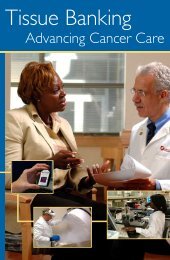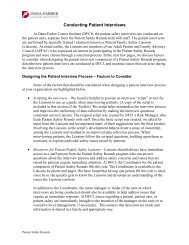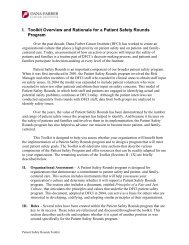Turning Point - Dana-Farber Cancer Institute
Turning Point - Dana-Farber Cancer Institute
Turning Point - Dana-Farber Cancer Institute
Create successful ePaper yourself
Turn your PDF publications into a flip-book with our unique Google optimized e-Paper software.
Women’s <strong>Cancer</strong>s Program physician/<br />
scientists Ursula Matulonis, MD, (left) and<br />
Dan Silver, MD, PhD, see promise in the<br />
use of PARP inhibitors for some breast and<br />
ovarian cancer patients.<br />
defects in DNA repair. In ovarian cancer,<br />
up to 70 percent of tumors are deficient<br />
in some part of the the BRCA<br />
DNA repair pathway, even though their<br />
BRCA genes may be normal. The<br />
problem could lie in regulation of<br />
BRCA gene expression or in trouble<br />
with other proteins in the same<br />
pathway. Whatever the cause, if the<br />
cells are relying on the PARP pathway<br />
to take up the slack, the inhibitor<br />
might work for these tumors, too.<br />
To test that idea, Dr. Matulonis is<br />
planning a trial to evaluate the compound<br />
AZD2281 in women with<br />
recurrent ovarian cancer that is still<br />
responsive to platinum, whether their<br />
tumors have BRCA mutations or not.<br />
In breast cancer, a similar opportunity<br />
may exist to treat an aggressive<br />
and stubborn class of tumors known as<br />
triple negatives. These cancers lack<br />
three clinical cancer markers, estrogen<br />
receptors, progesterone receptors, and<br />
the growth-promoting protein HER2.<br />
Because of this, the cells do not respond<br />
to anti-estrogen therapy, or to the<br />
HER2-targeted therapy trastuzumab.<br />
Dan Silver, MD, PhD, then a<br />
research fellow with David Livingston,<br />
MD, found that triple negative breast<br />
cancers share features of BRCAmutated<br />
tumors, including defects in<br />
DNA repair and an accompanying sensitivity<br />
to the DNA-damaging drug<br />
cisplatin. Could this parallel extend to<br />
sensitivity to PARP inhibitors?<br />
Dr. Silver, now an assistant<br />
professor in the Women’s <strong>Cancer</strong>s<br />
Program, believes so. He has found<br />
that some of the tumors are very sensitive<br />
to PARP inhibitors when grown in<br />
the lab. This work is being translated<br />
in a clinical trial in collaboration with<br />
Judy Garber, MD, MPH, the director<br />
of the Friends of <strong>Dana</strong>-<strong>Farber</strong> <strong>Cancer</strong><br />
Risk and Prevention Clinic. Building<br />
on the program’s recent success using<br />
cisplatin chemotherapy to treat triplenegative<br />
breast cancers, the researchers<br />
plan to combine a PARP inhibitor<br />
with cisplatin, and treat women with<br />
newly diagnosed triple-negative tumors,<br />
with or without BRCA mutations.<br />
Hitting the target<br />
Alan D’Andrea, MD, has spent<br />
the last 15 years uncovering the genes<br />
and proteins involved in all six DNA<br />
repair pathways, and he thinks there<br />
may be more tumors with the right<br />
profile for PARP inhibitor treatment.<br />
“Any cell that has become depen -<br />
dent on the PARP pathway for survival<br />
is fair game,” says Dr. D’Andrea, the<br />
chief of the Division of Radiation and<br />
<strong>Cancer</strong> Biology.<br />
To sort out the cancers that<br />
qualify, Dr. D’Andrea and colleagues<br />
are working out a series of laboratory<br />
tests to determine, in tumor samples,<br />
which DNA repair pathways are active.<br />
Having that information up front will<br />
allow doctors to figure out which<br />
patients are the best candidates for<br />
PARP inhibitor treatment. “This is a<br />
really good opportunity for personalized<br />
medicine,” Dr. D’Andrea says.<br />
“Our challenge is to find the perfect<br />
patients for the PARP inhibitors.”<br />
Many questions remain about the<br />
new approach. Which PARP inhibitors<br />
of several in the pipeline will emerge<br />
as the best? Should the inhibitors be<br />
combined with chemotherapy? Should<br />
they be used early in treatment, or<br />
later? Resistance to PARP inhibitors<br />
can emerge when cells find a way to<br />
reactivate the BRCA-dependent repair<br />
pathway – will that limit their use?<br />
It will take time to get the<br />
answers, but Dr. Matulonis sees PARP<br />
inhibitors as just the beginning of a<br />
whole new class of therapies. “As time<br />
goes on we are going to see more and<br />
more drugs targeting DNA repair,” she<br />
says. “For women with ovarian cancer<br />
who don’t have the BRCA mutation,<br />
this is going to be an area of new drug<br />
therapies and active research. This is an<br />
exciting time.”<br />
18<br />
<strong>Turning</strong> <strong>Point</strong> 2009<br />
www.dana-farber.org

















